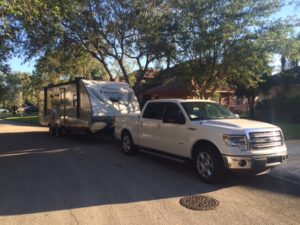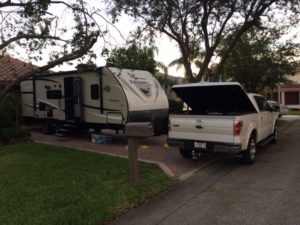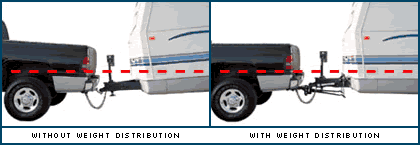
They say to “buy your second RV first.” But it’s best to buy your tow vehicle second. The tale of our purchase of Mr. Charlie our travel trailer discussed the thinking that drove our decision. We wanted a slide-out, a private master bedroom, an outdoor kitchen that would make us the envy of mornings at the music festival – all in a unit close to 21 feet or so. We settled on 25 feet, and were – and remain – thrilled with our buy.
But between the day we put money down on the trailer and drove her off the lot about four weeks later, we had a minor detail to address: the tow vehicle.
The saying “Buy your second RV first” has its roots in practicality often unseen by the first-time buyer. People tend to underestimate their needs and desires in their first home, boat, or RV. They might think austere is a way to nip expenses, or maybe they don’t want to bite off too much. But if you find your first unit cramps you with some “tiny house” ethos, and you’re bursting at the seams, you might also find yourself longing for that second RV.
So once we knew that the Coachmen Freedom Express 248 RBS would be ours, we had the specs needed to launch a methodical hunt for the right tow vehicle. The minivan we’d driven for 15 years was hardly up to the task of towing – or elevating daddy’s ego.
About those specs… A trailer rolls out of the factor with a “dry weight.” That’s the trailer’s weight without water, LP tanks or gas, a battery, or any belongings or supplies. Our trailer had a dry weight of 5,300 pounds. Its “tongue weight,” or how many pounds rest on the hitch ball when the trailer jack is retracted, is about 700 pounds.
There’s actually a ton of calculations and considerations beyond just the dry weight and tongue weight and this blog is by no means intended to provide critical advice needed to make your decision. (Click this site to calculate your tow capacity. Learn more from Camping World, RV Education 101, or MobileRVing).
As with the trailer, we knew what we wanted in a tow vehicle and about what we hoped to spend. We were game for a low-mileage, “gently” used truck. We wanted two-wheel drive, four full doors for occasional use by our family of five, and all the creature comforts, like leather interior, Bluetooth, satellite, and the like. I’d driven hand-me-down vehicles for 20-plus years. We were embracing a bit of “glamping” and it was time for daddy to enjoy his ride.
More important than aesthetics or fun or ego, we needed power enough to pull our new trailer of choice and a vehicle with a factory installed tow package.
About that tow package… You’re buying peace of mind on a number of levels. Most include a 7-wire harness and 4-/7-pin connector, a trailer wiring harness, a two-inch hitch receiver, an auxiliary automatic transmission oil cooler, an upgraded radiator, and upgraded rear bumper, a trailer brake controller, and a trailer sway control.
Packages also include a “Tow/Haul” modes. When activated, this option prevents the truck’s transmission from upshifting into overdrive when towing or carrying a load, and helps keep the transmission from “hunting” between higher gears while trailering.
 We looked at several 8-cylinder Dodge and GMC trucks, which had the power to pull our trailer. But we would have had to get a tow package installed.
We looked at several 8-cylinder Dodge and GMC trucks, which had the power to pull our trailer. But we would have had to get a tow package installed.
So, our hunt began. On the way out of town, we stopped in Orlando to visit Off Lease Only, a Florida-based dealership that buys cars and trucks – as the name would imply – coming off lease. They had plenty of trucks, but they were either too weak, or tricked-out show boats. A nice suburban couple, we weren’t looking for some macho truck.
Once home, we called dealers and looked online. We soon came across a 2013 Ford F150 Lariat edition with Ecoboost and less than 30,000 miles (and a clean CarFax). Research online and chats with RV dealers revealed the Ecoboost’s 6-cylinder engine, combined with the twin-turbochargers, could pull up to 11,300 pounds, and be more powerful and fuel efficient than most 8-cylinder trucks. (Click here if you want to learn / be bored by what we read about the F150).
 The dealer required we arrive with a truck sufficient to the task; a weight distributing hitch was part of the purchase. This delivers a more smooth, level ride; reduces tow vehicle sag; improves control, steering, sway, and stopping; and can help maximize the hitch’s tow capacity.
The dealer required we arrive with a truck sufficient to the task; a weight distributing hitch was part of the purchase. This delivers a more smooth, level ride; reduces tow vehicle sag; improves control, steering, sway, and stopping; and can help maximize the hitch’s tow capacity.
Our truck, named Donkey Jr as the smaller cousin to Barry’s larger GMC, now pulls Mr. Charlie with ease and confidence. And DJ’s no mule; after 15 years driving a minivan, daddy got his mojo back.
